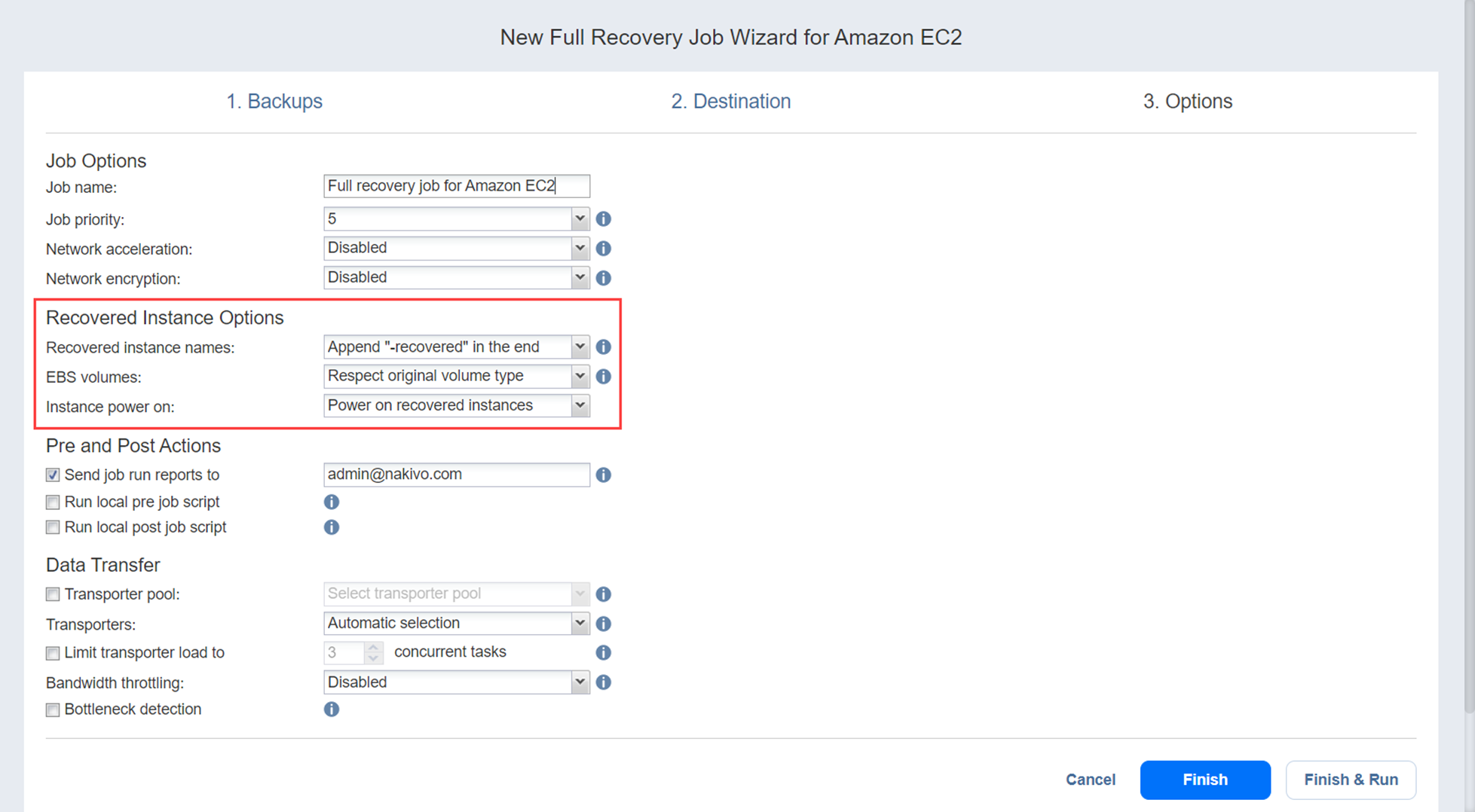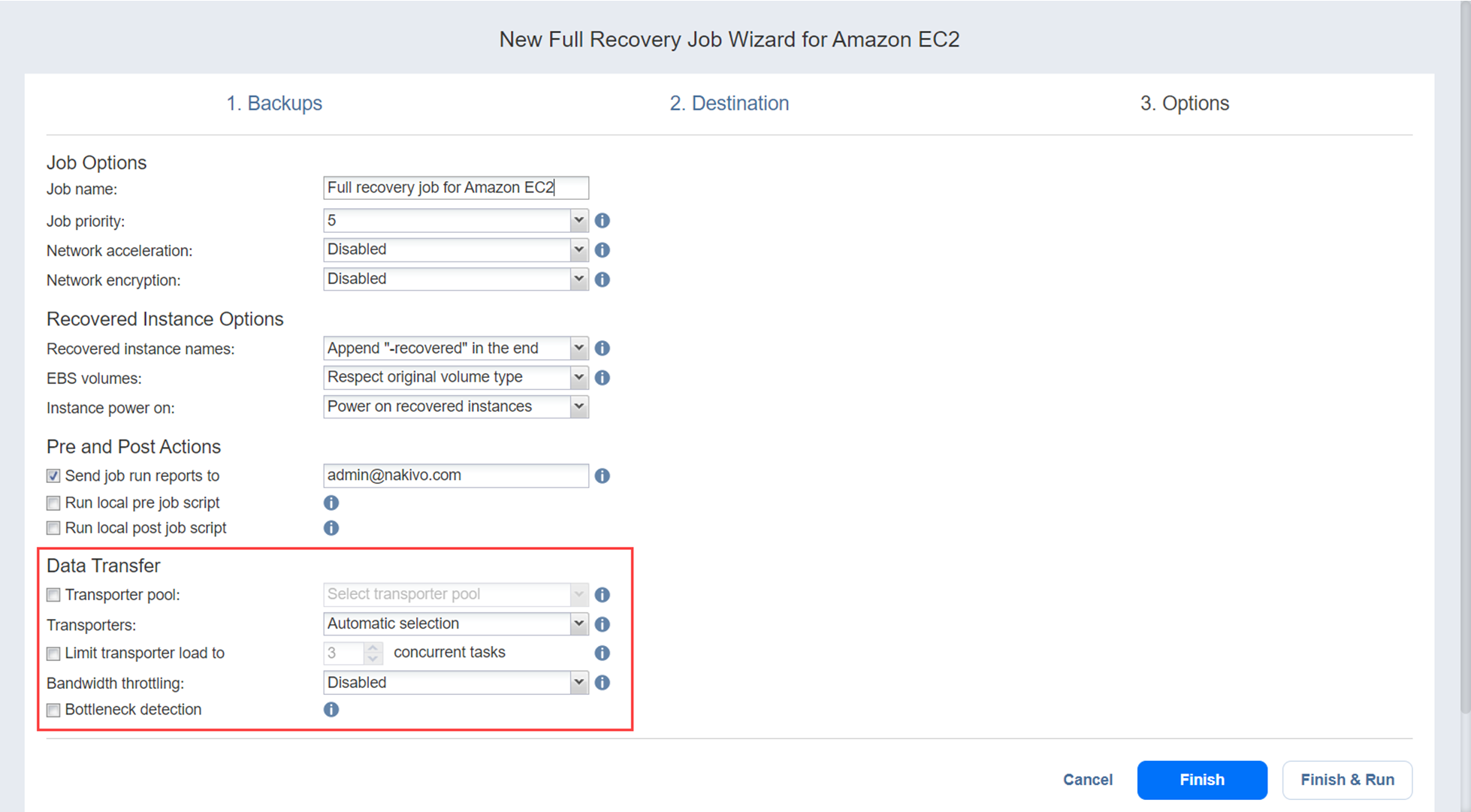Recovery Job Wizard for Amazon EC2: Options
On the Options page, set up recovery job options as described in the sections below:
Job Options
In this section, specify general options of your Amazon EC2 recovery job:
-
Job Name: Specify a name for the recovery job.
-
Job priority: Select a job priority level between 1 and 5, with 1 being the highest priority. Jobs with higher priority levels are prioritized by Transporters during job processing.
Note
This option is only available in the Enterprise, Enterprise Essentials, Enterprise Plus, MSP Enterprise, and MSP Enterprise Plus editions. -
Network Acceleration: When network acceleration is enabled, NAKIVO Backup & Replication will use compression and traffic reduction techniques to speed up data transfer. Select this option if you plan to recover VMs over WAN or slow LAN links. Refer to Network Acceleration for details.
-
Network encryption: When this option is enabled, VM data is protected with AES 256 encryption while traveling over the network. Data encryption increases the backup time and CPU load on machines running Transporters. Select this option when recovering over WAN without a VPN connection. Refer to Encryption in Flight and at Rest for more information.
Recovered Instance Options
In this section, you can specify the options for your recovered instance:
-
Recovered instance names: NAKIVO Backup & Replication allows you to change recovered Amazon EC2 instance names. By default, the text “- recovered” is appended to the end of recovered instance names. To change Amazon EC2 instance names, choose one of the following:
-
Append "recovered" in the end: Source instance names are used for recovered instance names and the specified text is added after the name of the recovered instance.
-
Leave recovered instance names as is: Recovered Amazon EC2 instances names are identical to the source instance names.
-
Enter custom recovered instance names: You can enter custom names for recovered Amazon EC2 instances.
-
-
EBS volumes: Choose one of the following options:
-
Use Magnetic type for all volumes: When this option is selected, NAKIVO Backup & Replication restores all EBS Volumes as Magnetic, regardless of the source EBS volume types.
-
Respect original volume type: When this option is selected, the type of source EBS volumes is preserved.
-
-
Instance power on: Select one of the following options:
-
Power on recovered instance: When this option is selected, the instances are powered on after recovery.
-
Do not power on recovered instance: When this option is selected, the recovered instances are not powered on after recovery.
-
Pre and Post Actions
NAKIVO Backup & Replication allows you to run a script before recovery begins (a pre job script) and after the recovery has completed (a post job script). The scripts can only be executed on the machine where the Director is installed. Also, you can set up email notifications to be sent to the specified recipients about job completion status. See the details below.
Running a Pre Job Script
To run a script before the product begins recovery, do the following:
-
Place a script file on the machine where the Director is installed.
-
Select the Run local pre job script option and click the settings link.
-
Specify the following parameters in the dialog that opens:
-
Script path: Specify a local path to the script on the machine where the Director is installed. A script interpreter should be specified.
Example (Windows): cmd.exe /c D:\script.bat
Example (Linux): bash /root/script.sh -
Job behavior: Choose either of the following job behaviors in relation to scrip completion:
-
Wait for the script to finish: With this option selected, recovery is started only after the script is completed.
-
Do not wait for the script to finish: When this option is selected, the product runs the script and starts backing up instances at the same time.
-
-
Error handling: Choose either of the following job behaviors in relation to scrip failure:
-
Continue the job on script failure: With this option selected, the job will perform recovery even if the script has failed.
-
Fail the job on script failure: With this option selected, if the script fails, the job will fail and recovery will not be performed.
-
-
Running a Post Job Script
To run a script after the product has finished recovery, do the following:
-
Place a script file on the machine where the Director is installed.
-
Select the Run local post job script option and click the settings link.
-
Specify the following options in the dialog box that opens:
-
Script path: Specify a local path to the script on the machine where the Director is installed. A script interpreter should be specified.
Example (Windows): cmd.exe /c D:\script.batExample (Linux): bash /root/script.sh
-
Job behavior: Choose either of the following job behaviors in relation to scrip completion:
-
Wait for the script to finish: With this option selected, the job will be in the “running” state until the script is completed.
-
Do not wait for the script to finish:With this option selected, the job will be completed even if the script execution is still in progress.
-
-
Error handling: Choose either of the following job behaviors in relation to scrip failure:
-
Continue the job on script failure: With this option selected, script failure will not influence the status of the job.
-
Fail the job on script failure: With this option selected, if the script fails, the job status will be set to “failed” even if recovery has been successful.
-
-
Email Notifications
NAKIVO Backup & Replication can send email notifications about job completion status to specified recipients.
To enable this option, make sure that Email settings are configured.
To send email notifications:
-
Select the Send job run reports to option.
-
Specify one or more email addresses in the text field. Use semicolons to separate multiple email addresses.
Data Transfer
In this section, you can specify data transfer options for the recovered instance.
Transporter Pool
If this option is enabled, only the transporters that belong to the selected transporter pool shall be used during the job run.
Transporters
In NAKIVO Backup & Replication, Transporters perform all of the heavy lifting: read data, compress data, transfer data over the network, perform data deduplication, and so on. If more than one Transporter is deployed for NAKIVO Backup & Replication, it is important to determine which ones should be used to read data from a particular instance and which ones should be used to write data to the target AWS Region.
Choose one of the following options:
-
Automatic selection: The product automatically determines which Transporters to use.
-
Manual - configured for all instances: Select this option to manually specify a single target Transporter to be used for writing data to target regions.
-
Manual - configured per region: Select this option to manually specify a Transporter for each region.
Transporter Load
You can limit the maximum number of Transporter tasks used by the job. By default, it is set to 3 concurrent tasks.
To change the default number of tasks, do the following:
-
Select the Limit transporter load to checkbox.
-
Specify the number of concurrent tasks in the corresponding box.
Bandwidth Throttling
Please follow the steps below to regulate the speed of data transfer over the network for your recovery job:
-
For the Bandwidth throttling option, choose Enabled.
Note
If bandwidth throttling is disabled for the current job, global bandwidth rules may still apply to your job. Refer to Bandwidth Throttling for details. -
Click the settings link that becomes available.
-
The Job Bandwidth Rules dialog box opens displaying the list of available rules. You have the following options:
-
Create a new bandwidth rule for your recovery job:
-
Click the Create New Rule button.
-
The New Bandwidth Rule dialog box opens. Refer to Bandwidth Throttling for details on creating a bandwidth rule.
-
Click Save.
-
-
Activate an existing bandwidth rule for your job. Select the checkbox to the left of the necessary bandwidth rule. To deactivate a bandwidth rule for your job, deselect the corresponding checkbox.
-
Edit a bandwidth rule. Click the Edit link for a bandwidth rule and modify it in the Edit Bandwidth Rule dialog box that opens.
-
Disable a bandwidth rule. Click the Disable link. The bandwidth rule will be disabled for all jobs.
-
Remove a bandwidth rule. Click the Remove link and then click Delete to confirm your operation.
-
Bottleneck Detection
When the Bottleneck detection option is enabled, additional information is collected and recorded in NAKIVO Backup & Replication logs in the course of data transfer for the purpose of bottleneck detection. Check this option to enable the Bottleneck detection capability of the Transporters engaged in the job.
Completing the New Full Recovery Job Wizard for Amazon EC2
Click Finish or Finish & Run to complete the job creation.
Note
If you click Finish & Run, you will have to define the scope of your job. Please refer to Running Jobs on Demand for details.



